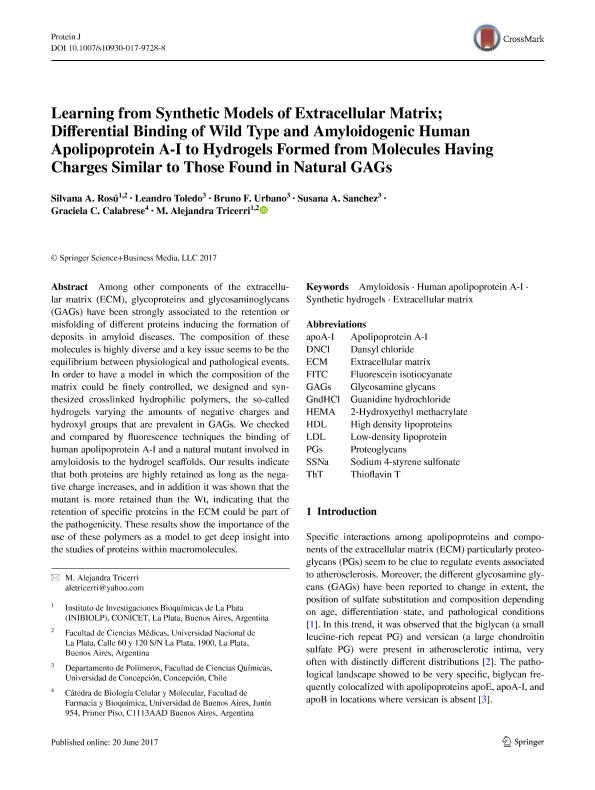Artículo
Learning from Synthetic Models of Extracellular Matrix; Differential Binding of Wild Type and Amyloidogenic Human Apolipoprotein A-I to Hydrogels Formed from Molecules Having Charges Similar to Those Found in Natural GAGs
Rosu, Silvana Antonia ; Toledo, Leandro; Urbano, Bruno F.; Sanchez Donoso, Susana Angelica; Calabrese, Graciela Cristina; Tricerri, Maria Alejandra
; Toledo, Leandro; Urbano, Bruno F.; Sanchez Donoso, Susana Angelica; Calabrese, Graciela Cristina; Tricerri, Maria Alejandra
 ; Toledo, Leandro; Urbano, Bruno F.; Sanchez Donoso, Susana Angelica; Calabrese, Graciela Cristina; Tricerri, Maria Alejandra
; Toledo, Leandro; Urbano, Bruno F.; Sanchez Donoso, Susana Angelica; Calabrese, Graciela Cristina; Tricerri, Maria Alejandra
Fecha de publicación:
08/2017
Editorial:
Springer
Revista:
Protein Journal
ISSN:
1572-3887
Idioma:
Inglés
Tipo de recurso:
Artículo publicado
Clasificación temática:
Resumen
Among other components of the extracellular matrix (ECM), glycoproteins and glycosaminoglycans (GAGs) have been strongly associated to the retention or misfolding of different proteins inducing the formation of deposits in amyloid diseases. The composition of these molecules is highly diverse and a key issue seems to be the equilibrium between physiological and pathological events. In order to have a model in which the composition of the matrix could be finely controlled, we designed and synthesized crosslinked hydrophilic polymers, the so-called hydrogels varying the amounts of negative charges and hydroxyl groups that are prevalent in GAGs. We checked and compared by fluorescence techniques the binding of human apolipoprotein A-I and a natural mutant involved in amyloidosis to the hydrogel scaffolds. Our results indicate that both proteins are highly retained as long as the negative charge increases, and in addition it was shown that the mutant is more retained than the Wt, indicating that the retention of specific proteins in the ECM could be part of the pathogenicity. These results show the importance of the use of these polymers as a model to get deep insight into the studies of proteins within macromolecules.
Archivos asociados
Licencia
Identificadores
Colecciones
Articulos(INIBIOLP)
Articulos de INST.DE INVEST.BIOQUIMICAS DE LA PLATA
Articulos de INST.DE INVEST.BIOQUIMICAS DE LA PLATA
Citación
Rosu, Silvana Antonia; Toledo, Leandro; Urbano, Bruno F.; Sanchez Donoso, Susana Angelica; Calabrese, Graciela Cristina; et al.; Learning from Synthetic Models of Extracellular Matrix; Differential Binding of Wild Type and Amyloidogenic Human Apolipoprotein A-I to Hydrogels Formed from Molecules Having Charges Similar to Those Found in Natural GAGs; Springer; Protein Journal; 36; 4; 8-2017; 374-383
Compartir
Altmétricas



